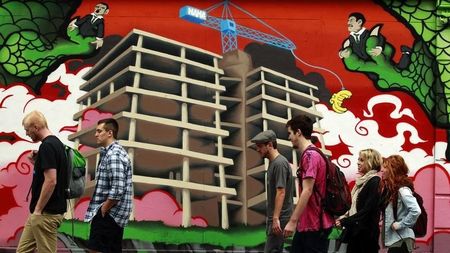By Padraic Halpin
DUBLIN (Reuters) - Ireland's government upgraded its growth forecasts for the second time in a week and said no new austerity measures would be needed in next month's budget, after figures released on Thursday showed the economy surged ahead in the second quarter.
The economy grew 1.5 percent in the second quarter to rise a whopping 7.7 percent from a year ago, central statistics office (CSO) data showed. Ireland also sold short-term debt at a yield of zero percent For the first time ever.
That news buoyed Finance Minister Michael Noonan, who said just last week that he expected the economy to grow by slightly more than 3 percent this year, compared with an earlier forecast of 2.1 percent, following a run of positive economic indicators.
"Last week, we were looking at the soft data. We haven't the numbers run yet but it will settle around 4.5 percent this year. It's somewhere around there and a bit less for next year," Noonan told reporters.
"Obviously, when you're in the catch-up phase of an economy after a recession, you'll get very high growth figures in the early stages, but as it settles I would hope we will have growth of around 3 percent for the next five years."
Less than 12 months out of a three-year EU/IMF bailout, Ireland is bucking the trend in the euro zone's stalled recovery. Employment is growing, exports are rebounding and consumers are beginning to spend again.
The year-on-year growth of 7.7 percent was the strongest recorded in Ireland since the early 2000s, Noonan said. By comparison, the euro zone recorded growth of just 0.7 percent in the same quarter.
The 1.5 percent quarterly rise significantly beat the 0.5 percent fall expected by economists polled by Reuters and followed growth of 2.8 percent in the first three months.
Noonan said his department believed the trend is set to continue. Davy Stockbrokers' chief economist Conall Mac Coille said that if GDP was even just flat for the second half of the year, 5 percent growth would not be out of the question.
"BOOM IS BACK"
While there have been definite signs of a substantive turnaround from the crisis that forced Ireland to seek aid, new EU calculation methods have also helped, putting the economy some 6 percent larger than previously estimated.
Noonan said the momentum would see the budget deficit fall to around 3.5 percent of GDP this year versus a target of 4.8 percent. That means 2 billion euros of tax hikes and spending cuts planned for next year would no longer be needed to reach the EU limit of 3 percent by the end of 2015.
The government instead wants to offer low and middle-income workers a tax break in October's budget, although it still may have to raise taxes elsewhere - including the introduction of water charges already announced - to fund them.
After seven years of relentless austerity and a banking crisis that has left around one in five homeowners unable to make mortgage payments in full, many people in Ireland have yet to feel the benefit of the upturn. The jump in the second quarter from a year ago was driven by a 13 percent increase in exports. Personal consumption posted its largest annual rise in almost four years, but that still amounted to just 1.8 percent year-on-year.
"At face value, the numbers suggest that the boom is back," said Austin Hughes, chief economist at KBC Bank Ireland.

"It shows a clearly improving economy. It's very encouraging to see the improvement in consumption, in construction. So a domestic recovery is taking hold, if a lot less intense that the headline number would suggest."
(Reporting by Padraic Halpin; Editing by Larry King)
